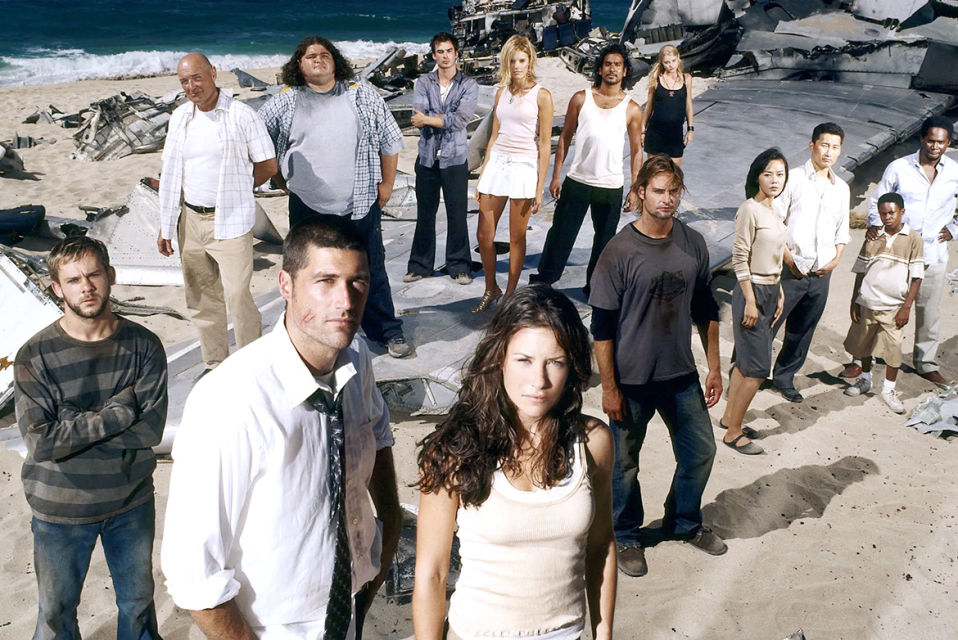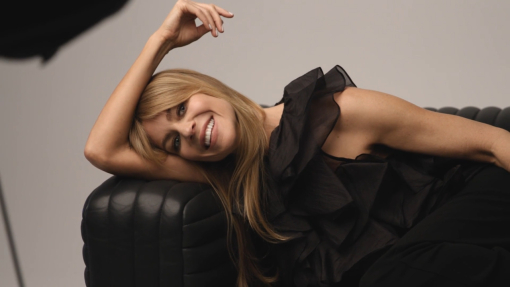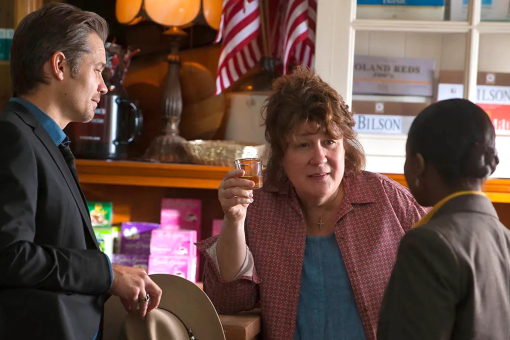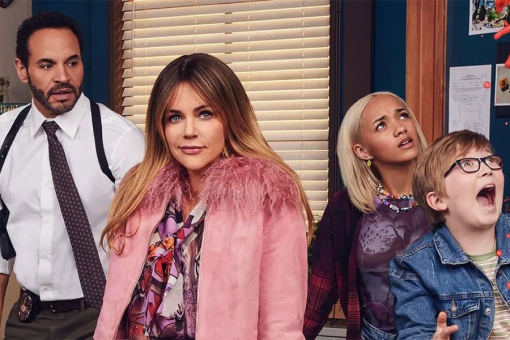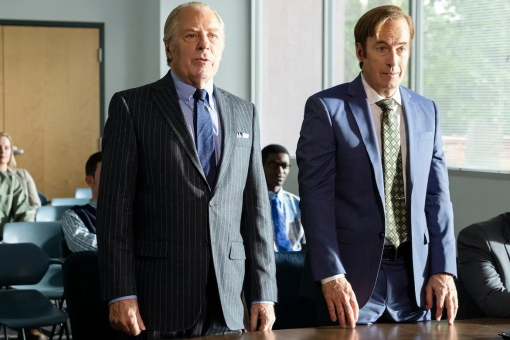An eye blinks open.
It belongs to a disoriented doctor who awakens with a jolt, on his back, in a jungle, wearing a suit and tie. Once he gets his bearings and spots a dog that we will come to know as Vincent, the doctor soon finds himself racing onto a desert island’s beautiful sandy beach.
There, he discovers the terrifying whine of a downed 747 engine and the equally terrifying screams of plane crash survivors.
That’s the thrilling and bold way co-creators and co-writers J.J. Abrams and Damon Lindelof opened the two-hour pilot of ABC’s Lost, which aired 20 years ago on September 22, 2004. (Part two would air a week later.) One of the most critically acclaimed pilots ever made, Lost’s first episode would make TV history with its “Twilight Zone meets Cast Away” approach to Oceanic Flight 815’s diverse group of passengers struggling to survive and escape an island that’s home to eerie whispers, polar bears, a hatch and, most memorably, a smoke monster.
With 18.6 million viewers tuning in that first night — ABC’s biggest pilot premiere audience since Steven Bochco’s Murder One, in 1995 — the sci-fi drama quickly earned a passionate fanbase by blending character-driven supernatural storylines with big emotional stakes in a way that audiences had never seen before, and it did so featuring one of the most likable and inspired ensemble casts ever assembled: Jack (Matthew Fox), the spinal surgeon who can’t help but help; the fugitive Kate (Evangeline Lilly); the charming con man Sawyer (Josh Halloway); estranged husband and wife Sun (Yunjin Kim) and Jin (Daniel Dae Kim); the loveable Hurley (Jorge Garcia); the enigmatic John Locke (Terry O’Quinn); the overwhelmed Michael (Harold Perrineau) and his young son, Walt (Malcolm David Kelley); the bickering step-siblings Boone (Ian Somerhalder) and Shannon (Maggie Grace); the witty (and heroin-addicted) rocker, Charlie (Lord of the Rings’ Dominic Monaghan); the repentent ex-Iraqi Republican Guard torturer Sayid (Naveen Andrews) and the very pregnant Claire (Emilie de Ravin).
Lost’s serialized approach to storytelling — something network TV vigorously avoided at the time — would pave the way for other shows to expand narratives. In fact, it would mark a key turning point in the way much of television was produced and consumed, with executives clearly seeing that audiences were just fine watching a show (even one that employed flashbacks like Lost did) where plotlines continued on week-to-week — as long as it featured characters and events they could invest in. Twenty years later, that investment is still paying off.
To commemorate Lost’s 20th anniversary, the Television Academy spoke with J.J. Abrams — who won an Emmy for directing the pilot — about why he was initially hesitant to make what would become one of his signature TV ventures, what it was like shooting the riveting beach sequence and getting a call on set from Tom Cruise that would change his life.
Television Academy: Writer Jeffrey Lieber took the first crack at Lost, then titled Nowhere, before you came aboard. How were you first approached to take on the project?
J.J. Abrams: I was working on another pilot idea; we had Alias on. And [chairman of ABC Entertainment Group, 2001-04] Lloyd Braun reached out and said he wanted to do a show about people who survived a plane crash, kind of like a Cast Away show. And he said, “Think about it and call me back.” [This was] on a Friday. And I thought about it. I called him back and I said, “Listen, I have an idea for some stuff. You're not going to like it, but I have a pitch.”
And I pitched him a much weirder, slightly more genre show — where the island wasn't just a regular island. Where there was a hatch, where there was something mechanical and odd and monstrous and maybe weird and spooky. I just thought, “Listen, that's not what you want. It's more of a sort of odd, Michael Crichton-y, strange thing than it is Cast Away." And he said, “I love it.”
The way the pilot drops us into that world, via the famous plane crash and triage on the beach opening sequence, is one of the most cinematic openings to a television show. And it looks very expensive. Was there ever any pushback from ABC on that opening? Like, did you ever hear “Do we really need that guy to get sucked into the engine?”
[Laughs] No, I think what happened was that when Lloyd Braun called about the idea, my guess is he sort of knew he was on the way out. And I think he was just trying to do something bold and — here's the thing, I think he was in a fearless mode. I had worked with him for a long time [at that point] and just really loved working with him. And I think when he called, there was a bit of a “no fucks to give” attitude. I have a feeling he was leaning into this in such a crazy way.
And when I met with Damon [Lindelof], who I'd never met, on that next Monday, we hit it off and started writing and turned an outline in on that Friday. And then [Braun] called, I think it was that Saturday, to say he was greenlighting it. He was greenlighting an outline.
How long did it take you and Lindelof to write the outline and script?
I think it was 11 weeks, 11 or 12 weeks to write it and cast it. To shoot it, cut it — everything. A two-hour pilot.
Wow. That’s a crazy-fast turnaround.
It was a crazy kind of go-for-it, no-time-to-second-guess mode. But while we were shooting, [Braun] left ABC. And it fell through the cracks, I think. He had already approved a bunch of stuff, and the [new] people coming in… It was already like the ship had sailed. So, I think if it had been normal days, my guess is we would have been told to scale it down or not make it at all.
How did you find out Braun was out? Were you on-set shooting the pilot when you got that call?
I don't remember exactly where I was when I heard that he had left. But I remember getting a call from the people who were taking his place saying, “We want to shoot an ending so we can air it as a TV movie.” I didn't know what that [ending] would have been, to this day, so we never did it.
Back to the opening sequence on the beach: The season one DVD shows some harrowing video of Dominic Monaghan looking a little rattled when the cables holding the burning jet engine that he’s standing close to snapped without warning.
I remember that moment because it was scary. It wasn't that he was so close [to it], though he wasn't far, because it was — we were cheating the perspective. It was like he was 20-some feet ahead, and the thing was well behind him. But it was a long lens, so it looked like it was falling.
How was your writing process with Lindelof? Did the two of you take walks to discuss story like you and Lawrence Kasdan did for Star Wars: The Force Awakens?
We took turns, and we had very little time. We outlined [it] together. And then we would go off and each write different scenes. There were times when we would write together. Whatever would work.
A lot of it was also reacting to actors we were meeting and being inspired by them and saying, “Oh my God, well, if Jorge [Garcia] is going to be Hurley, suddenly, he's got to pass out when they're doing the surgery [on the beach]. You just suddenly started seeing scenes, because if the couple that didn't speak English [Sun and Jin] were going to be Yunjin [Kim] and Daniel Dae Kim, what are some scenes we could do because of these actors? A lot of it was just being inspired by circumstance. I remember being on a scout with [producer] Sarah Caplan and Damon and everyone in Hawaii. And we were talking about the thing [they find] in the jungle. And Sarah said it should be a polar bear. And we were like, “That's a good idea.”
Shit was just happening at a crazy pace, so Damon and I would write in whatever form. A lot of it was together, some of it was writing separate scenes and then sharing pages and then each [of us] doing passes. It was just whatever got us there as fast as we could.
On the DVD commentary, you speak about how Jack — in an early version of the story — was supposed to be killed when the survivors reach the plane's cockpit and first encounter what we will come to know as the Smoke Monster. How did you and your partners decide “Nah, we’re not going to do that?"
We just kept hearing from people who were reading the script as soon as we finished it that they were pissed that Jack died. They just thought it was sort of — they were invested in this guy. He was this hero, they connected with him, so they felt that his death was a cheap trick, as opposed to finding some way to allow him to stay there and have to reckon with all of it. So, we decided that we didn't want to make people resent the show by doing something that felt like a fun thing as writers or filmmakers but a kind of cruel thing for an audience. So, we changed that.
Was that before or after you had talked to Michael Keaton about potentially playing Jack?
We talked to Michael about it early on when we thought [Jack] was going to die. Once we realized he wouldn't die, we knew that getting Michael would be an impossibility anyway.
But honestly — the Michael Keaton of it all — as much fun as it would have been to have him in the show, it felt like a gimmick. And the fact is, had we done it that way, in addition to it not being what it became, it would have been very different. When the show starts and you see Michael Keaton, you're like, “He's dead.” You sort of know what's going to happen.
As with Alias, you also came up with the opening titles for Lost. How did you land on that ominous chord that kinda serves as the show’s title theme?
That ended up happening because we were in the [sound] mixing stage, and we knew we needed the title. And we thought that would be a fun thing, just to have a sort of brief, weird [title animation]. And I did the animation and the audio because we need something, and we didn't have a lot of time. And so, I just did it.
It's funny. One, [that opening title sound] is a sound off of this great plugin from a company called Spectrasonics. It's now called Omnisphere — the plugin, I believe. And it was just a sound that was really cool and creepy. And I just played it super low. And one note: I won the ASCAP award for it.
Did you ever consider a more traditional opening titles or opening title theme?
Not really. After I did it, we sort of thought, “Well, we'll change that later and never did.”
Now, diving into some of the show’s most memorable scenes and moments: The opening triage sequence on the beach. There’s that great bit of business where Jack stops Boone from performing incorrect CPR on unconscious survivor Rose (The Fugitive’s L. Scott Caldwell), and Boone says, “Maybe we should go get a pen” to use for a tracheotomy and Jack, who just totally wants the guy gone, says dismissively, “Yeah, you go get me a pen.”
I don't remember who came up with it, if it was in the script or not. [Editor’s note: It is in the pilot script.] But I remember the feeling, which I just thought was a cool beat — given everything that was going on in that story. It was a telling thing, that one guy who's out of his league, who's just desperate to be useful in some way, a guy who kind of just wants to get rid of him, who's overwhelmed, and taking it in.
What I loved about the shooting of it is that there were, for the most part, a ton of vignettes of these little moments and scenes with different characters. And it was just fun, whether it was Boone and his sister Shannon, or whether it was Claire and Hurley. There were just these little moments that felt like windows into these lives that imply this peripheral vision of the moment you were seeing. And so, it was really fun to do it because it was like every time there was a new scene, it was like, “Oh, wow, now it's going to be Hurley and Sayid going into a scene together. Every time there was a scene like that, it just felt like there's a new dynamic.
Are the little beats like that some of what stands out the most for you, from the opening?
Things like that, even when Jack is running in the very beginning, and you see that tennis shoe in the tree. They're just these moments, these little details that just feel so sad and gruesome. Those are the things that stand out for me.
There’s also that little beat where Kate removes a boot from a dead passenger before hiking into the jungle. That gets me every time.
I know. It's so awful. And then she sees Terry with the orange [slice in his mouth].
It’s funny. On that, Damon and I were working really “seat of our pants” and doing everything we could to try to invest as much as we could in each moment — because we had so few moments with each character, for the most part, with a couple exceptions. And so, it was — I just remember, in doing the pilot, we were constantly asking ourselves, both in the writing of it and also in shooting it: “What feels right? What's the most intriguing? What's the thing that really makes us lean in?” And I think it'll allow for that kind of attention to detail, especially since there were a lot of scenes, a lot of quiet scenes, too, in some cases, with little dialogue but had a lot of behavior.
To that point, there’s the memorable scene where Kate sews up Jack’s wound and he gives the “count to five” speech after telling Kate about the time he was performing spinal surgery and nerve endings spilled out like angel hair pasta. Did you write that scene solo, or was that both you and Damon?
I remember we were both writing it. I remember calling a cousin of mine, who is a doctor, to ask for an experience where a doctor could make that kind of a mistake and then have to get it together to fix it. I remember the counting to five thing is really there as much to set up that moment later for Kate so that, when she's in the jungle, she has that payoff of doing it as well.
I remember shooting that scene, and there was something magical about the whole time being there and shooting that pilot, even though it was sometimes madness because the weather was changing constantly. And sometimes you didn't know what we were going to be able to shoot, given that it was suddenly raining. But we embraced it. And it was really wonderful, actually.
Any recollections filming Jack’s now famous “live together, die alone” speech?
Nothing that would stand out for this interview. But I do remember that it was the fundamental question of the show. Not only how are they going to survive, given the mysteries and monsters and uncertainties of the jungle, but just how are they going to survive this group of strangers? But I remember the tension between the characters and things coming to a head. And Sawyer and Kate and Sayid and all that, it was just wonderful for it to be addressed in that way.
As Jack, Kate and Charlie venture into the jungle to look for the cockpit section, there is a memorable tracking shot that reveals them approaching it.
It's so funny because all it was — what I was loving in that moment was we were just in the middle of this jungle with the nose of this jumbo jet sitting there. We shot the whole thing there. And I remember looking around, and it was such a mess of vines and roots and trees. But I remember looking at the normal shot that you might see of trekking through — and then the idea struck on how to make that reveal. So, they're coming in, they stop, and they see this thing. And then that gets your attention. Then they keep going. And I thought, “What if we move behind the tree? It'll then just look like they're moving on and out of frame.” And then if we wait long enough, and then all of a sudden, we start to move and reveal the cockpit, it just allows that one shot to be a whole bunch of story points in one shot. And it was just fun to do.
By the way, the interesting thing about that shot? If you watch the way they stop and they see this thing, and then they keep going, what they're stepping over is the dolly track. It looks like they're stepping over roots and things, but it's actually the dolly track.
So, when they go inside the cockpit and meet the injured pilot (Greg Grunberg), that’s not on a soundstage?
No, that was all in that actual cockpit, the nosecone of the jet. It's everything that we had. So that was the scene. That was the location. We just were overly ambitious and said, “Let's just shoot it all there.” For the whole thing we were inside, which just smelled awful. The whole thing was, as you could imagine, insanely claustrophobic and also unsettling and nauseating because it was at that canted angle. So, it just screwed up your equilibrium in a weird way. And to get up into the cockpit, we were literally having to climb up into that. It was crazy, but it worked.
And coming out of that scene is when the characters first encounter what fans would come to know as the Smoke Monster. At the time, did you know it was made out of smoke, or just “There’s a monster here”?
No, we didn't know. I think that where we were at that time was that we wanted to never see it. That was the thought. But I think my guess is that everyone will have a different memory of exactly where we were 20-some years ago in that moment, trying to figure that out. But yeah, we knew that it was something we didn't want to remotely hint at. And because it came post-Jurassic Park, we didn't want anyone to think it was a dinosaur. So, we purposely didn't do big steps and sounds of a thing. We just wanted to make it as terrifying and as subjective as possible.
So, to that point, how challenging was it to find that very distinct sound effect for the creature? I assume there was a lot of trial and error.
There was. I mean, arguably, because this whole thing was done so quickly — everything was a mad dash and scramble to figure things out. Like, for example, what music cues should play, where should cues play, the sound effects during the airplane turbulence, and then the crash. And then certainly the scene — Kate, when you realize that she's the prisoner, and the back of the plane rips off [in flashback], all those sound effects. Of course, the Smoke Monster was another one, both for that commercial break where they see the trees moving, and you hear the sound there, but also in the chase. I think the sound effects team did an amazing job.
Now, for the ending. How did you land on the survivors, including Shannon, going for a hike and they discover a radio broadcasting on a loop, for years, in French?
I think a lot of what we were trying to do was come up with the most unlikely and compelling story. And the fun of having it be in French was also that it allowed Shannon to suddenly have to actually play an important role in the story and come up with something. The fact that she happens to go on that hike, and then is the only one there who barely speaks French —I think, to us, it just felt like the most frightening possibility that there was this thing that had been playing for several years. And this terrifying — it's not even that the message itself is scary, which it is, but it's the idea that it's been playing for this long, and whoever sent it may still be there.
And I remember when we were shooting [that scene] — which, by the way, we were shooting when Tom Cruise called to say he wanted to meet about doing M:i:III.
But we were shooting that, and I remember the sun was going down, and at some nearby farm we could start to hear roosters. As the sun was going down, they were suddenly making all this noise. It was this very odd thing. I can imagine. Anyway, the intention there, I think, was about what felt like the most eerie and strange possibility that not only are they stuck here, but they're not the first. And that whoever was here before is that much more mysterious. And that inspired Charlie’s famous last line: “Guys, where are we?” It just felt like it was serving as a platform for that last line, yeah. And the question that we wanted everyone to be asking, which is like, “What is this place? Where have they ended up?”
One other thing, just real quick, when you're asking about that scene, the sequence where they're hiking and find the transmitter? I remember we were trying to figure out where and how do we shoot this climbing scene. And if you actually look at the climbing, the shots of them climbing, what I do think that's great is that because of the parallax with the background, it just feels epic.
But the way it happened, we were trying to find a location. We were driving around, and there was just this road, this area. I was looking at this area off the road that goes up the mountain, and I was like, “Wait a minute, what if we just do this here?” And if you actually were to pull back — and I don't know if there were behind-the-scenes photos of this — but if you were to pull back, they're just, like, two feet off the road [laughs]. They're climbing this little area that's right off the road. It was the easiest thing in the world to shoot. We just put the camera a little bit further back on the road, on a track. And we were just rocking and rolling with the background. And because it was such a long lens, and the background was so epic, it gives this feeling of scale. We had one shot where we composited them into a larger mountain. But, otherwise, every single shot was all in camera, the easiest in the whole world. It's hilarious. It was such a fun pilot to do.
Lost is streaming now on Netflix and Hulu.
This interview has been edited for length and clarity.

